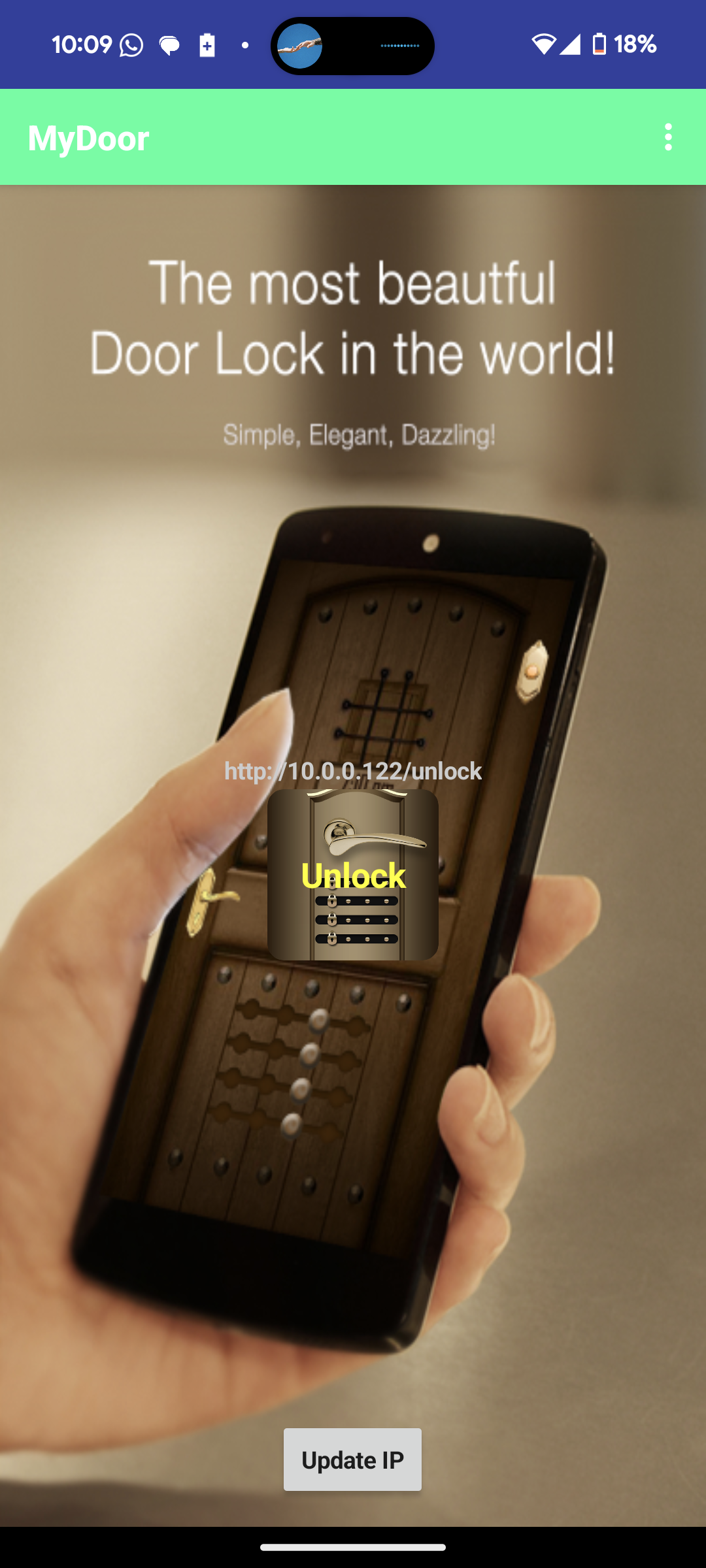ESP8266 Door Unlock System with Web Update and Static IP Configuration. A local door unlock system based on esp8266's local web server hosting capabilities
This project is a basic web server application that allows remote control of a door-lock relay using an ESP8266 and a 4-channel relay module. This setup provides control over the relay through a web interface, with the ESP8266 connected to WiFi and accessible via a static IP. You can update the firmware remotely through HTTP.
- Esp32
- Relay Module
- 5V Dc Power Supply
The ESP8266 connects to a local WiFi network with a pre-set SSID and password. Once connected, it:
- Hosts a web server with endpoints for testing connectivity and unlocking the door relay.
- Configures a static IP for consistent network access.
- Supports OTA (Over-The-Air) firmware updates through a browser.
- An ESP8266 microcontroller (ESP-01, NodeMCU, or any other variant)
- 4-channel relay module, with one channel used for door lock control
- A stable WiFi network
Ensure you have the following libraries installed:
ESP8266WiFi.h: Provides WiFi functions for ESP8266.ESP8266WebServer.h: Sets up a basic web server.ESP8266HTTPUpdateServer.h: Allows HTTP-based OTA updates.ESP8266mDNS.h: Enables mDNS (for local network access using a name instead of IP).
#define STASSID "xyz"
#define STAPSK "xyz"Replace "xyz" with your WiFi SSID and password. These will be used to connect the ESP8266 to your network.
The static IP setup ensures the ESP8266 maintains the same IP address each time it connects:
IPAddress staticIP(10, 0, 0, 55); // ESP8266 static IP
IPAddress gateway(10, 0, 0, 1); // WiFi Router (Gateway) IP
IPAddress subnet(255, 255, 255, 0); // Subnet mask
IPAddress dns(10, 0, 0, 1); // DNS IPAdjust these settings to match your network configuration.
void setup() {
pinMode(5, OUTPUT); // Set GPIO5 (Relay Control Pin) as output
digitalWrite(5, HIGH); // Initialize relay state to off (HIGH)
Serial.begin(115200); // Start serial communication
WiFi.mode(WIFI_AP_STA); // Set WiFi to both AP and Station mode
WiFi.hostname(host); // Set hostname for local access
WiFi.begin(ssid, password); // Start WiFi connection
while (WiFi.waitForConnectResult() != WL_CONNECTED) {
WiFi.begin(ssid, password);
Serial.println("WiFi failed, retrying.");
}
MDNS.begin(host); // Start mDNS for hostname access
httpUpdater.setup(&httpServer);
httpServer.on("/", handleRootPath);
httpServer.on("/unlock", handleUnlockPath);
httpServer.begin();
Serial.printf("HTTPUpdateServer ready! Open http://%s.local/update in your browser\n", host);
Serial.print("IP address: ");
Serial.println(WiFi.localIP());
pinMode(2, OUTPUT);
}This block handles initial configuration:
- Configures GPIO5 to control the relay, setting it initially to
HIGH(off). - Connects to the WiFi network and configures mDNS for network-based naming access.
- Sets up HTTP server endpoints and starts the server for handling requests.
void loop() {
httpServer.handleClient(); // Handles incoming client requests
MDNS.update(); // Updates mDNS service
}This loop keeps the web server responsive to client requests and maintains mDNS services.
void handleRootPath() {
httpServer.send(200, "text/plain", "Hello world");
}This endpoint returns a simple "Hello world" message for basic connectivity testing.
void handleUnlockPath() {
digitalWrite(5, !digitalRead(5)); // Toggle relay state
delay(250); // Wait 250ms for relay activation
digitalWrite(5, !digitalRead(5)); // Reset relay state
httpServer.send(200, "text/plain", "Door Unlocked");
}This endpoint toggles GPIO5 (relay control pin) to unlock the door and responds with "Door Unlocked".
You can update the ESP8266 firmware over HTTP:
curl -F "image=@firmware.bin" esp8266-doorunlock.local/updateReplace "firmware.bin" with the path to your new firmware file.
- Static IP: Uncomment
WiFi.config(staticIP, subnet, gateway, dns);to activate the static IP configuration. - OTA Access: Access OTA at
http://esp8266-doorunlock.local/update. Replace"esp8266-doorunlock.local"with your hostname or IP if different.
This setup provides a secure, low-cost IoT door unlocking system. Make sure to replace STASSID and STAPSK with your network details before deploying.
Apk Included




